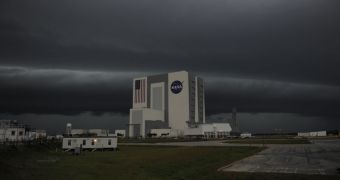A severe thunderstorm that affected the coasts of Florida on Wednesday and Thursday battered the space shuttle Endeavor with torrents of rain and powerful winds. The bad weather delayed some training exercises astronauts were completing, and caused other delays as well.
The orbiter is scheduled to take of the International Space Station (ISS) on its final mission soon. The STS-134 flight will launch on April 19, so preparations at NASA are in full swing.
But engineering teams were forced to take a break on March 30-31, as powerful storms made work on the Launch Pad 39A facility dangerous. Astronauts training on an aircraft designed to mimic the behavior of the shuttle were also grounded.
The shuttle and its six-astronaut crew are now at the Kennedy Space Center (KSC), in Cape Canaveral, where preparations are underway to get Endeavor ready for its final mission ever. But the storm even forced NASA to move the location of a press conference it had scheduled to take place at the pad.
Journalists and officials had to move indoors. “Thanks for coming out on this beautiful Florida morning. The weather today is going to change our plans for training at the pad,” told reports Endeavor's commander, Mark Kelly.
Planned inspections of the shuttle were also canceled due to heavy rains. A tornado warning was still in effect yesterday, and a large funnel cloud loomed over the KSC at around 8:30 EDT (1330 GMT).
Kelly and Greg Johnson – Endeavor's pilot for STS-134 – managed to carry out only a few landings with NASA's heavily-modified Gulfstream aircraft before rain forced mission controllers to shut down the training session.
“I got two approaches and Greg got one before we had to land due to some lousy weather – rain, and lightning getting close to the field. But, as you guys know, we only need one approach in the orbiter,” Kelly told reports yesterday, quoted by Space.
Officials with the US Air Force (USAF) Weather Squadron said that top wind speeds at the launch pad reached 90 miles per hour (79 knots), while sustained speeds revolved around 57 mph (50 knots).
Lightnings also struck about half a mile from the launch pad, and KSC officials say that the storms may have caused some minor damage on the shuttle. A few small pieces of the insulation foam covering its external fuel tank were found missing.
As soon as the weather subsides, experts will conduct a thorough investigation of the spacecraft, its tank and its twin solid rocket boosters, in order to determine the full extent of the damage.

 14 DAY TRIAL //
14 DAY TRIAL //